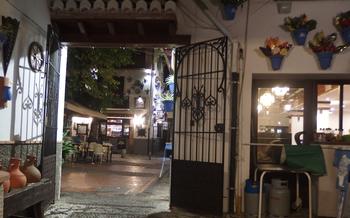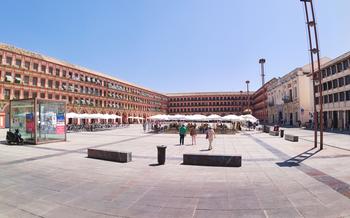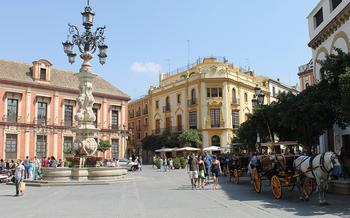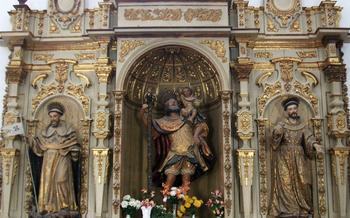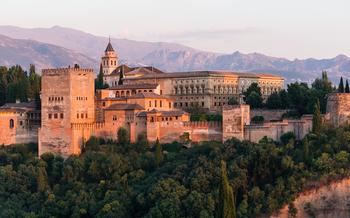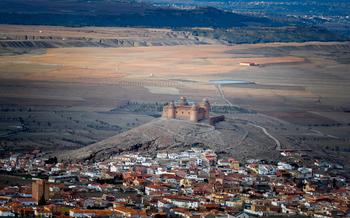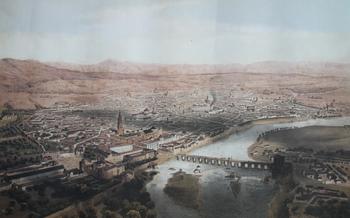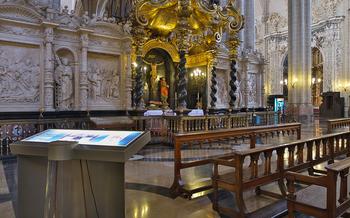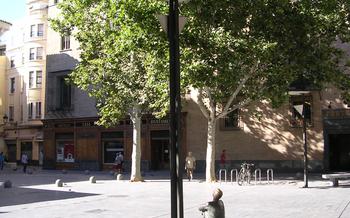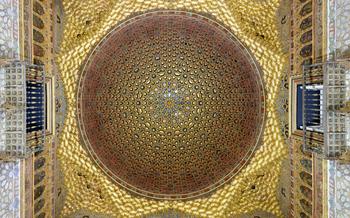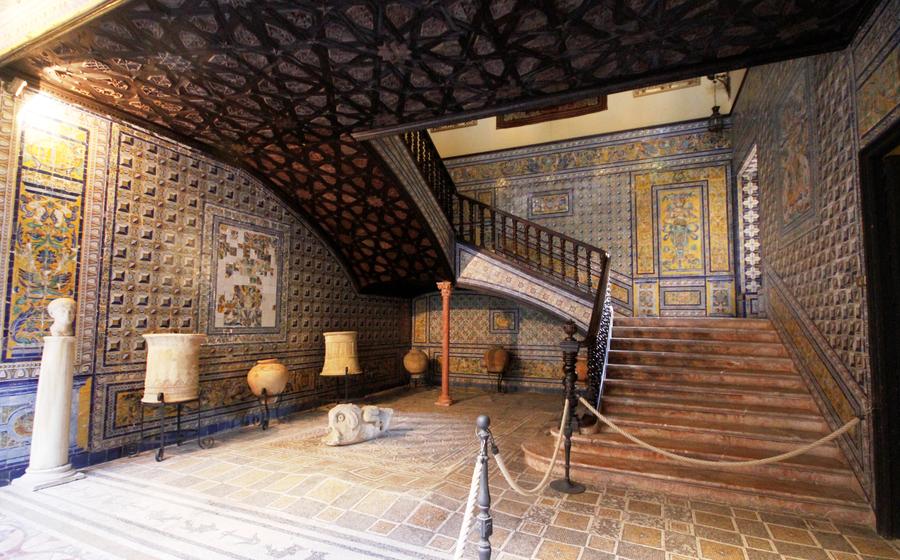
Palacio de la Condesa de Lebrija
- Palacio de la Condesa de Lebrija: A Historical Gem
- Exploring the Courtyard
- Marveling at the Mudéjar Details
- Stepping into the Grand Salón
- Unveiling Hidden Treasures
- Admiring the Art Collection
- Wandering Through the Gardens
- Learning about the Lebrija Family
- Experiencing the Palace at Night
- Attending Cultural Events
- Booking a Guided Tour
- Planning Your Visit
- Capturing Memorable Moments
- Savoring Local Delights
- Insider Tip: Discovering Hidden Gems
Palacio de la Condesa de Lebrija: A Historical Gem
In the heart of Seville, Spain, stands the magnificent Palacio de la Condesa de Leb intrigue, serving as the residence of the noble Lebrija family and hosting countless significant events. Today, it stands as a museum, inviting visitors to step back in time and immerse themselves in the splendor of a bygone era.
Exploring the Courtyard
As you step into the courtyard of the Palacio de la Condesa de Lebrija, you are immediately struck by its captivating charm. The centerpiece of this open space is a magnificent fountain, its intricate carvings and delicate spouts creating a soothing melody as water cascades into the basin below. The courtyard is surrounded by elegant arches and columns, adorned with intricate tilework and vibrant frescoes that depict scenes from history and mythology.
Look closely at the artistic elements that adorn the courtyard. The tiles, a hallmark of Mudéjar architecture, feature geometric patterns and vibrant colors that dance in the sunlight. The frescoes, painted by talented local artists, offer a glimpse into the rich history and cultural heritage of Seville. Each detail, from the sculpted figures to the decorative motifs, contributes to the courtyard's enchanting atmosphere.
The fountain, a symbol of life and abundance, holds a special significance in the courtyard. Its presence evokes a sense of tranquility and serenity, inviting visitors to pause and appreciate the beauty of the surroundings. The water's gentle flow and the melodious sound it creates add to the courtyard's magical ambiance, making it a perfect spot for contemplation and relaxation.
Marveling at the Mudéjar Details
The Palacio de la Condesa de Lebrija is a treasure trove of Mudéjar architecture, a unique style that blends Islamic and Gothic elements. Look for the intricate plasterwork and tilework that adorn the walls and ceilings, featuring geometric patterns and floral motifs. The Mudéjar influence is also evident in the use of horseshoe arches, which can be seen throughout the palace, including in the courtyard and the Grand Salón.
One of the most striking examples of Mudéjar craftsmanship is the fountain in the courtyard. It features a hexagonal basin with intricate tilework and a central column decorated with geometric patterns. The fountain is a symbol of the fusion of cultures that took place in Spain during the Middle Ages, when Islamic and Christian influences intermingled to create a unique artistic style.
Stepping into the Grand Salón
The heart of the Palacio de la Condesa de Lebrija is undoubtedly the Grand Salón, a majestic chamber that exudes grandeur and opulence. Step inside and be mesmerized by its soaring ceiling, adorned with intricate stucco work and embellished with gold leaf. The walls are lined with tapestries depicting scenes from mythology and history, adding a touch of artistry to the space.
The most striking feature of the Grand Salón is its impressive collection of furniture and decorative objects. Exquisitely carved wooden chairs, upholstered in rich fabrics, are arranged around a central table, inviting guests to linger and converse. Elaborate chandeliers hang from the ceiling, casting a warm glow over the room. Every detail in the Grand Salón has been carefully considered, creating a harmonious and visually stunning space.
Originally conceived as a formal reception room, the Grand Salón served as a place for the Condesa de Lebrija to entertain guests and conduct business. Today, it continues to be used for special events and exhibitions, showcasing the palace's rich history and cultural significance.
Unveiling Hidden Treasures
Beyond the grand halls and exquisite gardens, the Palacio de la Condesa de Lebrija holds secret chambers that reveal intriguing stories of the past. These hidden spaces, once concealed from public view, offer a glimpse into the private lives of the Lebrija family and the palace's remarkable history.
Discover the hidden library, a sanctuary of knowledge filled with rare books and manuscripts that tell tales of adventure, romance, and intrigue. Imagine yourself as a scholar of old, poring over ancient texts and uncovering forgotten secrets within these hallowed walls.
Explore the secret passageways that connect different parts of the palace, allowing the Lebrija family to move unseen through their grand estate. These hidden corridors served as a means of escape during times of danger, adding an element of mystery and intrigue to the palace's allure.
Unravel the secrets of the hidden chapel, a sacred space where the Lebrija family sought solace and spiritual guidance. Adorned with intricate religious iconography and bathed in the soft glow of candlelight, this hidden sanctuary invites contemplation and reflection, transporting visitors to a realm of spirituality and devotion.
Each of these hidden spaces holds its own unique story, waiting to be discovered by curious explorers. As you delve deeper into the palace's secrets, you'll gain a profound appreciation for the rich history and captivating narratives that lie hidden within its walls.
Admiring the Art Collection
The Palacio de la Condesa de Lebrija is home to a remarkable collection of art that spans different eras and artistic styles. Among the highlights is a stunning portrait of the Condesa de Lebrija herself, painted by the renowned artist Francisco de Goya. The portrait captures the essence of the Condesa, showcasing her elegance and poise. Another notable piece is a series of tapestries depicting scenes from the life of Saint Francis of Assisi. These tapestries are exquisite examples of Flemish craftsmanship and showcase intricate details and vibrant colors.
In addition to these masterpieces, the palace also houses a collection of sculptures, ceramics, and furniture from different periods. Each piece has a unique story to tell, providing a glimpse into the history and culture of Spain. Visitors can spend hours wandering through the galleries, admiring the diverse range of artworks and learning about the artists who created them. The art collection at the Palacio de la Condesa de Lebrija is a testament to the rich artistic heritage of Spain and is a must-see for any art enthusiast.
Wandering Through the Gardens
The Palacio de la Condesa de Lebrija boasts enchanting gardens that transport visitors to a serene oasis amidst the bustling city. Designed with meticulous attention to detail, the gardens are a harmonious blend of Moorish and Renaissance influences, creating a captivating fusion of styles.
Strolling through the lush pathways, visitors are greeted by an array of exotic plants and flowers, each carefully selected for its vibrant color and fragrant aroma. Jasmine, bougainvillea, and hibiscus burst forth in a kaleidoscope of hues, while the air is filled with the sweet scent of orange blossoms and lavender.
The gardens are adorned with intricate fountains and sculptures, adding a touch of elegance and whimsy to the surroundings. The central fountain, with its cascading water and intricate tilework, becomes a focal point, inviting visitors to linger and admire its beauty.
Symbolism abounds in the garden's design, with each element carefully chosen to convey a deeper meaning. The cypress trees, with their slender silhouettes reaching towards the sky, represent eternity and the connection between heaven and earth. The rose bushes, with their delicate blooms, symbolize love and beauty, while the myrtle trees embody hope and fidelity.
As visitors explore the gardens, they will discover hidden nooks and secluded corners, each offering a unique perspective and a chance to escape the hustle and bustle of city life. Whether seeking a moment of tranquility or inspiration, the gardens of the Palacio de la Condesa de Lebrija provide a sanctuary for the soul.
Learning about the Lebrija Family
The Palacio de la Condesa de Lebrija is inextricably linked to the Lebrija family, whose legacy is deeply woven into the history of Spain. The palace takes its name from the Condesa de Lebrija, Doña Regla Manjón y played a pivotal role in Spanish history and culture for centuries. Their contributions span diverse fields, including literature, science, and politics. One of the most notable members of the family is Antonio de Lebrija, known as "Nebrija"**, a renowned humanist and scholar who played a crucial role in the development of the Spanish language.
The Lebrija family's influence is evident throughout the Palacio de la Condesa de Lebrija. From the eclectic art collection to the intricate Mudéjar details, the palace reflects the family's refined taste and appreciation for beauty. Their passion for knowledge and culture is palpable within the palace walls, making it a treasure trove of historical and artistic significance.
Experiencing the Palace at Night
The Palacio de la Condesa de Lebrija transforms into a magical realm when night falls. Its illuminated façade, reflecting the glow of the surrounding city lights, creates an enchanting atmosphere. As you step through the grand entrance, you'll be captivated by the play of shadows and light, highlighting the intricate details of the palace's architecture.
Special events and performances are often held at the palace at night, offering visitors a unique and immersive experience. Immerse yourself in the rhythms of traditional Spanish music or be transported to another era with theatrical performances that bring the palace's history to life.
If you're a photography enthusiast, the nighttime offers a perfect opportunity to capture stunning shots of the palace. Experiment with long exposure techniques to capture the ethereal glow of the illuminated façade or focus on the intricate details of the courtyard under the soft moonlight.
Whether you prefer to admire the palace's beauty in silence or join in the festivities, a visit to the Palacio de la Condesa de Lebrija at night is an experience you won't forget.
Attending Cultural Events
The Palacio de la Condesa de Lebrija is not just a historical monument but also a vibrant cultural hub. Throughout the year, the palace hosts a diverse range of cultural events that celebrate Spanish heritage, art, and music. From intimate concerts to captivating exhibitions, there's always something to engage and inspire visitors.
Types of Cultural Events
The palace's grand spaces provide a unique setting for a variety of cultural events. Visitors can enjoy classical music concerts performed by renowned musicians in the enchanting courtyard. Art exhibitions showcase works by local and international artists, highlighting various artistic styles and themes. Flamenco performances, a quintessential Spanish art form, bring the palace's walls to life with their passionate rhythms and mesmerizing dance moves. Literary events, such as book readings and discussions, offer a platform for authors to share their work and engage with readers.
Schedule and Ticket Information
To stay updated on the upcoming cultural events at the Palacio de la Condesa de Lebrija, check the palace's official website or social media pages. Ticket prices vary depending on the event, and reservations are recommended to avoid disappointment. Some events may offer special discounts for students, seniors, or families.
Tips for Getting the Most out of Your Experience
- Arrive early to secure a good seat and soak in the atmosphere of the palace before the event starts.
- Dress appropriately for the occasion. While formal attire is not required, avoid wearing shorts or tank tops to show respect for the historical setting.
- Take advantage of the opportunity to explore the palace's other attractions before or after the event. The courtyard, gardens, and art collection are all worth exploring.
- Capture your memories by taking photos or videos, but be mindful of any restrictions or guidelines regarding photography.
- Engage with the performers or speakers after the event. Many artists are happy to chat with their audience and share their insights.
Booking a Guided Tour
To truly delve into the rich history and captivating stories of the Palacio de la Condesa de Lebrija, consider booking a guided tour. Led by knowledgeable and passionate guides, these tours offer an immersive experience that brings the palace's past to life.
There are various types of tours available, catering to different interests and preferences. Standard guided tours provide a comprehensive overview of the palace, highlighting its architectural features, Mudéjar influences, and the Lebrija family's legacy. Thematic tours focus on specific aspects, such as the palace's art collection, hidden rooms, or the role of women in its history.
Tours are conducted in multiple languages, ensuring that international visitors can fully appreciate the palace's significance. Booking in advance is recommended, especially during peak tourist season, to secure your spot and avoid disappointment.
Guided tours offer several advantages. They provide in-depth insights and anecdotes that might otherwise be missed. The guides can point out hidden details, explain the symbolism behind the architecture and décor, and share intriguing stories about the Lebrija family and their connections to Spanish history.
Moreover, guided tours allow you to make the most of your time at the palace. The guides ensure a smooth and organized visit, helping you navigate the different sections efficiently and ensuring you don't miss any highlights.
Whether you're a history buff, an architecture enthusiast, or simply someone who appreciates beautiful spaces, booking a guided tour of the Palacio de la Condesa de Lebrija is an excellent way to enhance your experience and gain a deeper understanding of this cultural gem.
Planning Your Visit
Planning a trip to the Palacio de la Condesa de Lebrija is essential for a seamless and enjoyable experience. While the palace is open throughout the year, the best time to visit is during the shoulder seasons (spring and autumn) when the weather is pleasant and the crowds are smaller. To avoid the peak tourist season and experience the palace's tranquility, aim to visit on weekdays rather than weekends or holidays.
To make the most of your visit and learn about the palace's rich history and significance, consider booking a guided tour. Tours are available in various languages and provide insights into the palace's architecture, art collection, and the Lebrija family's legacy. Ensure you arrive a few minutes early for your tour to avoid any delays.
The Palacio de la Condesa de Lebrija is wheelchair accessible, with ramps and elevators available for visitors with limited mobility. Strollers and baby carriages are also permitted, making it a family-friendly attraction. However, it's important to note that photography and videography are restricted in certain areas of the palace to preserve the integrity of the artwork and artifacts.
Capturing Memorable Moments
The Palacio de la Condesa de Lebrija offers a feast for the eyes, and capturing its beauty through photography and videography is a must. Whether you're a seasoned photographer or simply want to document your visit, here are some tips to help you create unforgettable memories:
- Photography and Videography Guidelines:
-
Tripods and Selfie Sticks: Tripods are generally not allowed inside the palace, and selfie sticks are prohibited. To ensure you capture steady shots, bring a compact camera or use your smartphone's camera.
-
Ideal Spots for Photos:
-
Courtyard: The courtyard is a great spot for capturing the palace's stunning architecture and intricate details.
-
Grand Salón: The grandeur of the Grand Salón, with its intricate ceiling and opulent décor, offers a perfect backdrop for photos.
-
Gardens: The lush gardens provide a picturesque setting for capturing the palace's natural beauty and serene ambiance.
-
Tips for Creating Share-Worthy Content:
-
Storytelling: Use your photos and videos to tell a story about your experience at the palace.
-
Hashtags: Use relevant hashtags when sharing your photos on social media to increase your visibility.
-
Composition: Experiment with different angles and compositions to create visually appealing shots.
Savoring Local Delights
Strolling through the picturesque streets surrounding the Palacio de la Condesa de Lebrija, you'll find an array of culinary delights waiting to be savored. From traditional Spanish tapas to gourmet restaurants, the area offers a diverse gastronomic experience.
For a taste of authentic Spanish cuisine, venture into the nearby restaurants and cafés. Indulge in mouthwatering tapas, such as patatas bravas, croquetas, and jamón serrano, paired with a glass of refreshing sangria. Don't miss the opportunity to try the local specialty, salmorejo, a chilled tomato soup garnished with jamón and hard-boiled eggs.
If you seek a fine dining experience, Seville boasts several Michelin-starred restaurants within a short distance of the palace. Delight in innovative dishes crafted with fresh, seasonal ingredients, accompanied by an exquisite wine selection.
For a sweet treat, head to one of the traditional pastry shops, known as confiterías. Sample the delicious tortas de aceite, almond-filled pastries, or the delicate polvorones, shortbread cookies that melt in your mouth.
Remember to embrace the Spanish dining culture by taking your time and savoring each dish. Engage in lively conversations with locals and fellow travelers, as sharing meals is a cherished social experience in Spain.
Insider Tip: Discovering Hidden Gems
Beyond the main attractions of the Palacio de la Condesa de Lebrija, there are hidden gems waiting to be discovered by the curious traveler. One such gem is the secret garden, tucked away behind the main courtyard. This intimate oasis features a secluded fountain, vibrant flowers, and a serene atmosphere, offering a tranquil escape from the bustling city.
Another hidden gem is the library, which houses a collection of rare books and manuscripts that tell the story of the Lebrija family and their contributions to Spanish culture. For history buffs, this library is a treasure trove of knowledge and insight.
Finally, don't miss the underground passage that leads from the palace to the nearby church. This secret tunnel was once used by the Lebrija family to attend mass without being seen by the public. Today, it offers visitors a glimpse into the clandestine history of the palace and its inhabitants.
Whether you're a history enthusiast, an art lover, or simply someone who appreciates hidden treasures, the Palacio de la Condesa de Lebrija has something to offer. So, take the time to explore beyond the main attractions and discover the hidden gems that make this palace truly unique.
